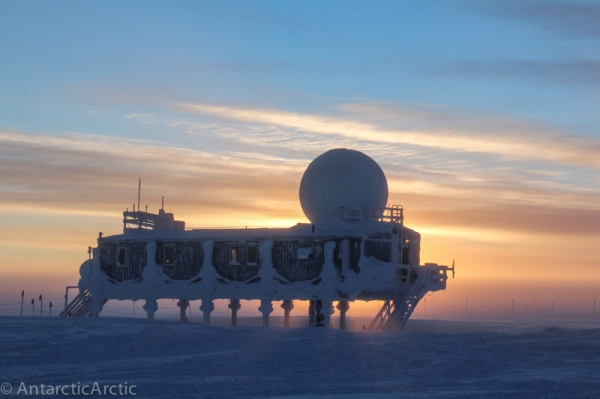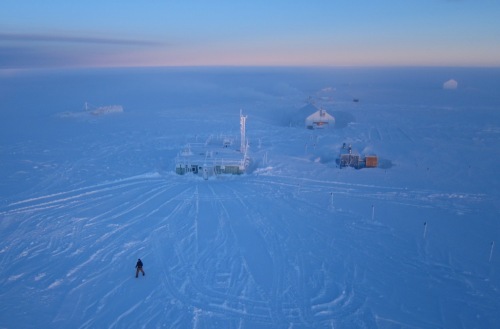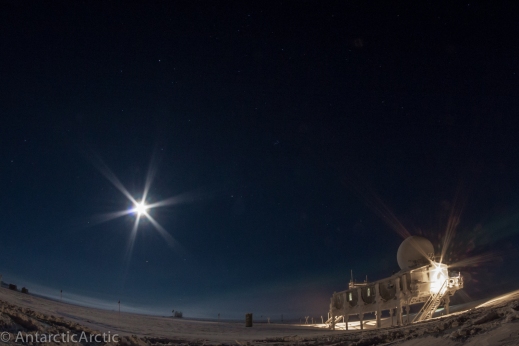Last winter I was in the midst of my monthly building checks when I went out to visit the Mobile Science Facility (MSF). It was a dark day and snowing lightly. I noticed a flickering light on the snow out of the corner of my eye and proceeded to the back of the building where there are no outside lights. In the shadow of the building and under the angled LiDAR beam the ground was alive with bright green flashes of light.

A starstax image

The LiDAR glows green atop the MSF

The MSF on 11/28

Taking IcePICs
The LiDAR laser is mounted to the roof of the Mobile Science Facility (MSF) and is part of the ICECAPS project which is looking at atmosphere, precipitation, radiation, and cloud properties over the Greenland ice sheet.
The science techs had noticed these reflected lights earlier, but I had not seen it before. It was truly magical! The lights danced and flickered around lasting only a fraction of a second. Some streaked across in lines, others just flashed a tiny spot, still others revealed intricate interference patterns on the snow. Later that evening the techs and I returned with our cameras. Like auroras, it’s difficult to capture the movement, but still beautiful and interesting none the less!

It was reminiscent of disco ball lights, but faster and brighter. At first we called it “Disco Ice,” but that wasn’t quite right…lasers, neon green, a high frequency pulse… “Rave Ice” was a better fit.
Intrigued, we decided to do some research to find out what exactly was happening. Was this a normal LiDAR by-product? How was it related to the falling or blowing snow? What did it tell us about current atmospheric conditions? Surprisingly we found almost nothing on the topic. One paper described a similar phenomenon, however the authors said it had only ever been observed in controlled optics research labs and computer programs, never outside. They speculated that snow or ice crystal size, shape, and orientation could be inferred from the light patterns displayed. One of the science techs wanted more information and reached out to the authors sharing some photos we had taken. They were amazed.
This phenomenon has most certainly been occurring since the LiDAR was first installed in 2010. However, it is rare, can only be seen in the dark, and had never been documented until last winter (2016-17). Over the next few months the ICECAPS Primary Investigators, the science tech here, and the optical researchers collaborated to write an article explaining the unique phenomenon. It was published in the July 2017 edition of Applied Optics!
They were able to link the patterns we photographed, the ice crystals we collected, and the shapes and patterns they had modeled in their labs. For example, a bullseye pattern is created by a smooth sided disc, while a bright spot surrounded by six broken dashed lines is a distinct hexagonal plate. We saw both of these patterns and also collected these types of crystals during the event.
It appears that this phenomenon occurs relatively often. When seen from afar the LiDAR beam glints and sparkles reflecting off the crystals. But conditions must be just right to get well defined patterns. There can’t be too much freezing fog, it can’t be blowing tons of snow, it needs to be dark, and there needs to be some precipitation. While any crystals will reflect the laser the most intricate patterns are a result of proper snowflakes and other more complex crystal shapes; something that requires relatively high humidity (so not too cold) and not too much turbulence (otherwise they’ll break apart). Up here it tends to be either very cold, calm, and clear with no precipitation, or warm, humid, and windy with far too much turbulence for complex crystals to form.
Earlier last week however there was an abnormally warm period with very low winds. Temperatures in some areas of Greenland were as much as 50˚F above average. While temperatures here have been around -50˚F the week prior and again this week, during the warm event Summit temps reached +7˚F! This warm spell affected much of Greenland and was so unusual it made the news:
https://thinkprogress.org/omg-heat-wave-scorches-greenland
https://weather.com/news
It also proved to be absolutely perfect conditions for Rave Ice. I had noticed the sparkling LiDAR beam on Tuesday afternoon and knew it would be worth hauling my tripod and camera out there. As I was walking out one of the techs called out on the radio that I should come out to see…and it was some of the best yet. I set up my tripod and started taking pictures while the tech collected snow samples, photographing the ice crystals, and recording meteorological data.

The science tech in the unheated shelter used to photograph ice crystals

Observing the Rave Ice
These are some of the crystals she photographed:
And these are some stacked images of the reflections:





















 We also experimented with freezing bubbles. However, with no trees or mountains to break the wind it’s generally too windy for bubbles to last very long. It’s also been pretty cold lately at -75F last week so they freeze very quickly, often bursting.
We also experimented with freezing bubbles. However, with no trees or mountains to break the wind it’s generally too windy for bubbles to last very long. It’s also been pretty cold lately at -75F last week so they freeze very quickly, often bursting.
























 be a shift at -40°F where materials become a bit more brittle, the cold just a bit more sharp. Around -60°F there is another step; the solid steel of the loader tracks creaks and crackles, bamboo shatters, leather becomes solid, and your exhalations whoosh loudly past your ears as the moisture freezes instantly.
be a shift at -40°F where materials become a bit more brittle, the cold just a bit more sharp. Around -60°F there is another step; the solid steel of the loader tracks creaks and crackles, bamboo shatters, leather becomes solid, and your exhalations whoosh loudly past your ears as the moisture freezes instantly.






























 Last week we hit a low of -73F according to the Green House thermometers. This week however, has been dark and stormy with temps around -30F and winds around 30kn. Lots of shoveling to be done!
Last week we hit a low of -73F according to the Green House thermometers. This week however, has been dark and stormy with temps around -30F and winds around 30kn. Lots of shoveling to be done!





 We celebrated the holidays with a rare 2-day weekend and a nice dinner. The Big House smelled of baking and the atmosphere was festive with our decorated plywood tree. Everyone enjoyed a little down time to rest and catch up with family back home.
We celebrated the holidays with a rare 2-day weekend and a nice dinner. The Big House smelled of baking and the atmosphere was festive with our decorated plywood tree. Everyone enjoyed a little down time to rest and catch up with family back home.

